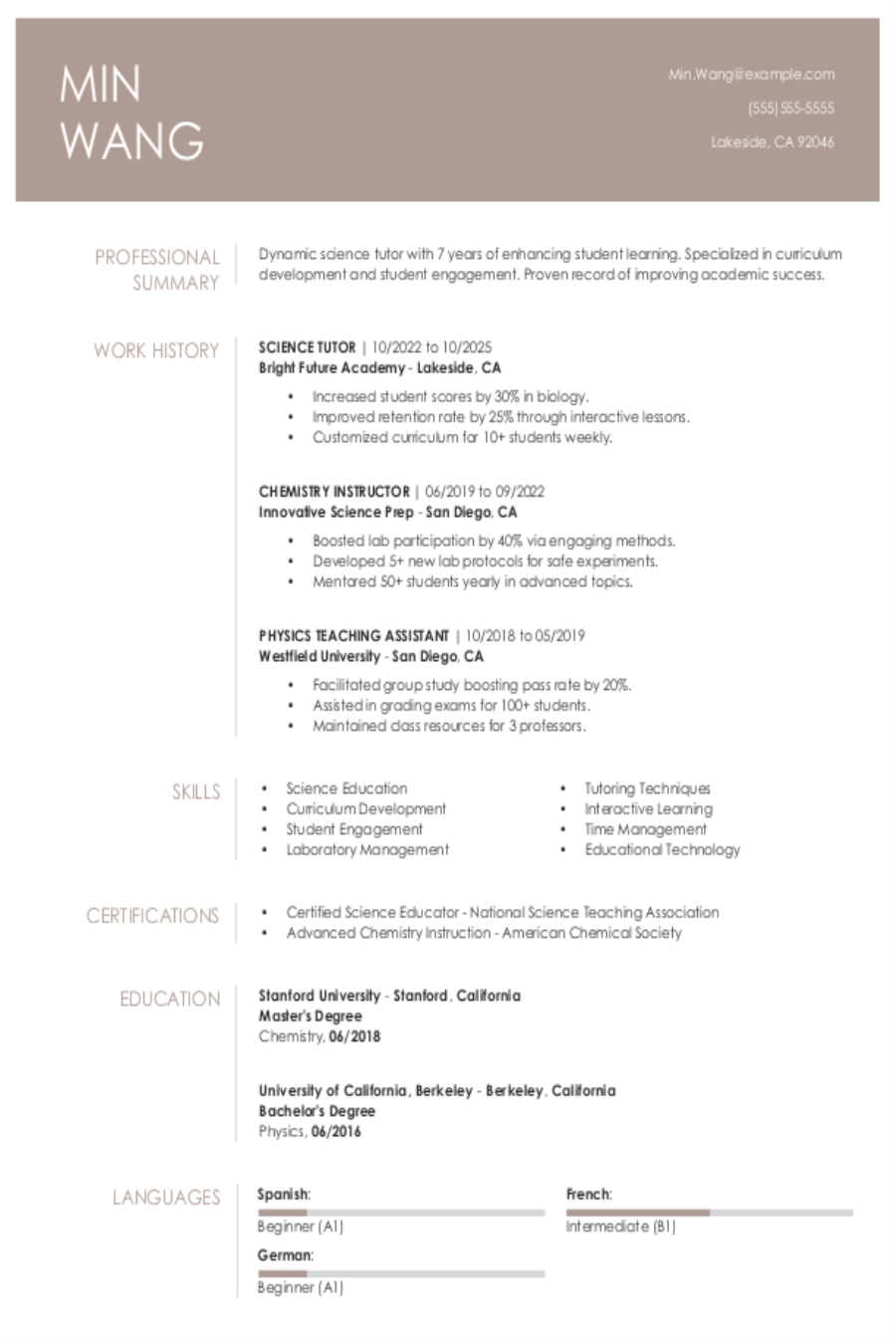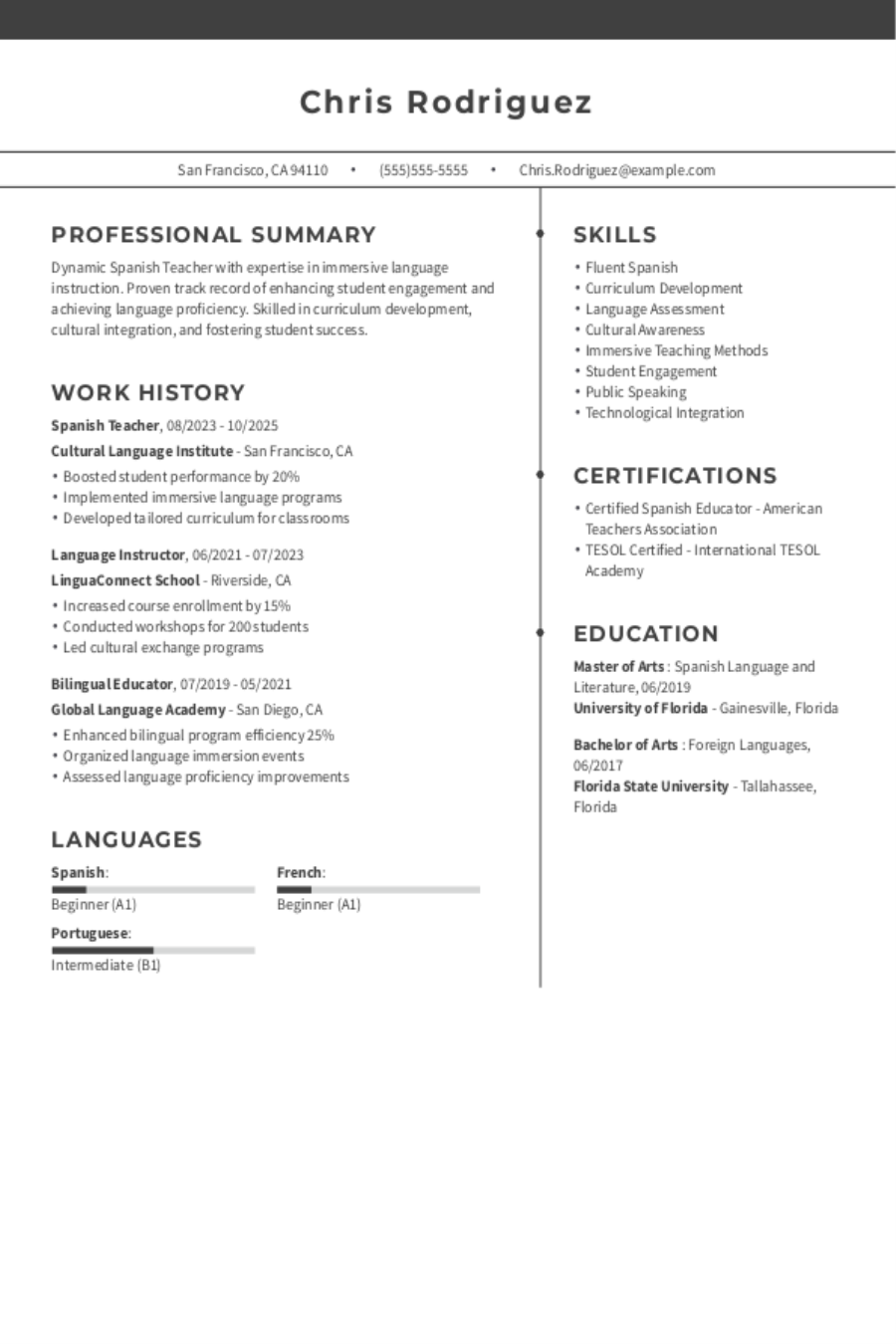Popular Carpenter Resume Examples
Entry-level carpenter resume
An entry-level resume for a carpenter should highlight relevant skills, hands-on training, certifications, and completed projects to showcase practical knowledge, even with limited professional experience.
Emphasizes soft skills: This resume highlights the applicant's strong leadership and problem-solving skills, which effectively compensate for limited experience.
Showcases education: This resume prominently displays the candidate's education, bolstering their credibility as a beginner candidate.
Mid-career carpenter resume
A mid-career carpenter resume should emphasize a mix of hands-on experience, technical skills, and evidence of ongoing learning to demonstrate adaptability and growth in the trade.
Encourages quick scanning: Clean design and thoughtful organization highlight a carpenter's skills, making it easy for employers to quickly identify relevant qualifications and accomplishments.
Balances skills and experience: This job seeker’s resume showcases a strong mix of technical carpentry skills and progressive experience, effectively illustrating their journey from woodworker to carpenter while highlighting achievements in project management and sustainability.
Experienced carpenter resume
An experienced carpenter resume should prioritize highlighting relevant skills, successful projects, and professional development to clearly demonstrate career growth and expertise in the field.
Optimized for ATS: The resume uses a clean template that merges a refined header with an ATS-friendly resume design, ensuring it appeals to both hiring managers and automated systems during the recruitment process.
Quantifies achievements: Quantifiable achievements provide clarity and impact, showcasing a carpenter's skills in measurable terms. By highlighting specific percentages or numbers, recruiters can easily grasp the significance of the job seeker's contributions and successes in previous roles.
No experience carpenter resume
A resume for an applicant with no experience should highlight relevant skills, practical knowledge gained through projects, and any hands-on training or workshops to showcase the job seeker's potential in the trade.
Leads with education: Including an education section near the top of this resume, along with an accomplishments section that includes relevant coursework, such as structural analysis and carpentry basics, showcases this candidate's expertise.
Overcomes lack of work history: Emphasizing hands-on skills from volunteer work highlights the applicant's readiness for a carpenter role, showcasing their ability to contribute effectively despite limited formal experience.
More resume examples
Additional Guides
Carpenter Resume Template
Looking to create a standout application? This carpenter resume template serves as an excellent starting point that you can easily adapt with your personal details and experience.
Chris Jones
Riverside, CA 92508
(555)555-5555
Chris.Jones@example.com
Professional Summary
Seasoned carpenter with 9 years of experience, skilled in furniture construction and blueprint reading, excelling in project management and customer satisfaction.
Work History
Carpenter
Precision Woodwork - Riverside, CA
January 2022 - September 2025
- Constructed custom wood furnishings up to $50k revenue
- Optimized materials usage, reducing waste by 15%
- Managed project timelines, ensuring 100% on-time completion
Woodwork Specialist
Masterpiece Renovations - San Diego, CA
January 2017 - December 2021
- Exceeded client satisfaction scores to 95%
- Led team of 5 in complex renovation projects
- Completed 50+ residential carpentry tasks annually
Joiner
Elite Carpentry Services - Riverside, CA
January 2016 - December 2016
- Fabricated custom cabinetry, increasing sales by 20%
- Performed precise measurements improving fit quality
- Executed detailed finish work enhancing aesthetics
Skills
- Furniture construction
- Blueprint reading
- Material optimization
- Project management
- Team leadership
- Finish carpentry
- Customer satisfaction
- Safety compliance
Education
Diploma Carpentry
Elmwood Technical College Springfield, IL
December 2013
High School Diploma General Studies
Springfield High School Springfield, IL
December 2011
Certifications
- Certified Carpenter - National Association of Carpenters
- Project Management for Carpenters - Construction Management Institute
Languages
- Spanish - Beginner (A1)
- French - Beginner (A1)
- German - Intermediate (B1)
Must-Have Skills on a Carpenter Resume
An impressive skills section is critical for a strong carpenter resume.
The data below showcases the key hard and soft skills for a carpenter resume as per Resume Now’s research.
When you're ready to improve your resume, try our AI Resume Skills Generator. It recommends tailored hard and soft skills based on your specific job title, ensuring you present a comprehensive and customized skill profile.
Writing Your Carpenter Resume
Having explored these impressive resume examples, you are now prepared to discover how to write a resume that stands out. We will guide you through the writing process in detail, covering each section step by step.
List your most relevant skills
An effective skills section on your carpenter resume should focus on both technical skills like woodworking and framing, as well as soft skills such as attention to detail and teamwork. Including these abilities will help you stand out to recruiters who are looking for applicants that can thrive in a collaborative environment.
To maximize your chances of getting noticed, make sure to integrate keywords from the job listing into your skills section. By doing so, you demonstrate that you understand the requirements of the position while also optimizing your resume for applicant tracking systems. This strategy ensures that both human recruiters and technology recognize you as a strong applicant who meets their needs.
Example of skills on a carpenter resume
- Proficient in reading and interpreting blueprints to ensure accurate project execution
- Adept at using carpentry tools and machinery with precision and care
- Strong communicator with a collaborative approach to team projects
- Committed to maintaining high standards of safety and quality craftsmanship
Your skills section is your opportunity to showcase your readiness for the carpenter role. Highlight specific technical skills relevant to carpentry, such as skill with tools and materials, alongside essential soft skills like teamwork and attention to detail. This combination demonstrates that you are well-equipped to meet the job's challenges effectively.
Highlight your work history
Your work experience section must highlight not just what you've done but how you've excelled in each role. Focus on showcasing achievements that reflect your craftsmanship and problem-solving abilities, ensuring you incorporate industry-relevant keywords that capture the attention of hiring managers.
For every job entry, include key details like your title, the name of the employer, and the dates you were employed. These elements help establish your credibility and provide a timeline of your experience. Consider adding specific projects or notable accomplishments that demonstrate your skills in action.
Example of a carpenter work experience entry
- Carpenter
ABC Construction Co. - Denver, CO
March 2019 - Present - Construct wooden frameworks and structures for residential and commercial projects, adhering to blueprints and specifications with precision
- Collaborate with contractors and architects to ensure project feasibility and compliance with safety regulations, improving overall workflow efficiency by 15%
- Use advanced carpentry tools and techniques to complete tasks accurately, reducing material waste by 10% through careful planning
- Train new apprentices in carpentry skills and safety practices, fostering a culture of teamwork that improved project completion times by 20%
- Consistently received positive feedback from clients for high-quality workmanship, contributing to a 30% increase in repeat business.
Aim for clarity by using concise bullet points that highlight your achievements. Focus on key results or skills, ensuring each entry is effective without excessive detail.
Add portfolio work to your resume
For carpenters, showcasing your craftsmanship on your resume is vital while also inviting potential employers to explore your broader portfolio. Highlighting completed projects can effectively demonstrate your skills without overwhelming the reader.
Position a link to your portfolio at the top of your resume near your contact details. Include a section labeled "Project Highlights" where you briefly describe 3-4 of your best works, emphasizing key techniques or materials used. This layout keeps it organized and visually appealing.
Example of a portfolio highlights section
- Custom Furniture Design for Modern Living – Crafted bespoke furniture pieces that improved client satisfaction ratings by 45%
- Home Renovation Project for Jones Family – Successfully completed a kitchen remodel that increased home value by 20%
- Deck Construction for Green Valley Park – Built an eco-friendly deck recognized in local community newsletter for sustainability efforts
- Interior Carpentry for Downtown Boutique – Installed custom shelving, improving retail space functionality and aesthetics, praised by the owner
Include your education
The education section of your carpenter resume should present your qualifications in reverse-chronological order starting with your most recent training or certification. Include relevant diplomas and certificates while omitting high school details if you have advanced vocational training or certifications in carpentry.
If you are currently enrolled in a carpentry program or pursuing additional professional certifications, list the highest level of education completed and include an expected graduation date. It may also be beneficial to add bullet points that highlight specific skills learned, tools mastered, or projects completed during your coursework.
Common certifications for a carpenter resume
- Certified Carpenter (CC) – National Association of Home Builders (NAHB)
- Journeyman Carpenter Certification – United Brotherhood of Carpenters and Joiners of America
- Green Certified Carpenter (GCC) – National Association of Home Builders (NAHB)
- OSHA 10-Hour Construction Safety – Occupational Safety and Health Administration (OSHA)
Sum up your resume with an introduction
Creating an effective profile section on your carpenter resume is essential for making a strong first impression. This section serves as a brief introduction that encapsulates your skills, experience, and what you bring to the table. A well-crafted profile can grab the attention of hiring managers and encourage them to delve deeper into your qualifications.
For seasoned carpenters, a professional summary is often the best choice. This provides a quick overview of your career highlights, enabling employers to easily recognize how you stand out in your field. If you're new to the workforce, opening with a resume objective that communicates your goals can set the tone for your resume.
Professional summary example
Skilled carpenter with over 10 years of experience in residential and commercial construction. Demonstrated success in delivering high-quality craftsmanship while adhering to strict timelines and budgets. Proficient in framing, cabinetry, and finish work, with a keen eye for detail that ensures client satisfaction and structural integrity.
Resume objective example
Enthusiastic carpenter eager to apply strong attention to detail, creativity, and problem-solving abilities in a collaborative construction environment. Committed to delivering high-quality craftsmanship while continuously learning and adapting to new techniques for improved project outcomes.
To make a strong impression, job seekers for carpenter positions should start their resume profile with their job title. Whether you choose a professional summary or an objective statement, this approach helps employers quickly understand your identity and skills in the trade.
Add unique sections to set you apart
Including optional resume sections for carpenter positions can effectively highlight your unique qualifications and set you apart from other job seekers. These additional sections allow you to present a fuller picture of your professional identity.
By sharing relevant hobbies or volunteer experiences, you demonstrate not just your skills but also the values that drive you. Employers appreciate insights into how you spend your time outside work, as it reflects your dedication to continuous learning and personal development in the field of carpentry.
Three sections perfect for a carpenter resume
- Work Samples: Adding a portfolio section to your resume can highlight your craftsmanship as a carpenter. Showcase 3-5 standout projects, detailing design challenges and your unique solutions, which will effectively demonstrate your skill and creativity to potential employers.
- Client Testimonials: Incorporating client testimonials can significantly improve your resume, showcasing your craftsmanship and dedication. A couple of compelling quotes reflecting your reliability and skill can set you apart in the competitive carpentry field.
- Awards and Recognition: Showcasing awards to your resume highlights your achievements. Include any relevant certifications, industry accolades, or notable projects, along with the issuing organization and date to improve your profile.
5 Resume Formatting Tips
- Choose a format that matches your career stage.
Selecting the appropriate resume format is essential for showcasing your skills. If you have extensive experience, a chronological format effectively highlights your career progression. For those just starting out, a functional resume can emphasize relevant skills over work history. Consider using a combination format to clearly present both aspects.
- Pick a smart resume template.
Using a professional resume template can greatly improve your document's readability. It streamlines the formatting process, ensuring your skills and experience stand out. If you opt for a custom layout, prioritize clarity and select fonts that are easy to read, making it ATS-friendly as well.
- Select an appropriate font.
To improve readability, select a clear professional font for your resume. Fonts like Arial, Calibri, or Georgia are excellent choices that maintain a polished look while ensuring easy scanning by both ATS and hiring managers.
- Use consistent formatting.
Align your resume text to the left with uniform margins to create a neat and professional layout that catches the eye of potential employers.
- Keep your resume to one or two pages.
When crafting your resume, remember that resumes should be one page long unless you have extensive experience. Focus on keeping the content concise and relevant to ensure employers quickly see your qualifications and strengths.
What’s the Average Carpenter Salary?
Carpenter salaries vary based on location, career level, and qualifications.
This data, provided by the Bureau of Labor Statistics, will show you expected salary ranges for carpenters in the top 5 highest-paying states, including the District of Columbia. The figures reflect the most current salary data available, collected in 2024.
- Full Range
- Most Common (25th–75th percentile)
- Average
Hawaii
Most common: $64,110 - $109,380
Illinois
Most common: $49,340 - $105,070
California
Most common: $57,900 - $95,360
Washington
Most common: $60,000 - $90,900
Massachusetts
Most common: $58,380 - $95,530
Tools for Your Job Search
Are you gearing up to apply for that carpenter position you've been eyeing? Before you hit send on your application, use our ATS Resume Checker. This essential tool offers valuable insights into how your resume will perform with the automated systems that many construction companies use for initial screenings.
Looking for a way to craft your resume more effectively? Our AI Resume Builder provides tailored content recommendations specific to your carpentry skills and experience, along with professional templates designed to showcase your work effectively to potential employers.
Frequently Asked Questions
Last Updated: October 1, 2025
Absolutely. A cover letter is important because it adds depth to your resume and allows you to communicate directly with potential employers. It’s the perfect opportunity to express your passion for carpentry and highlight how your skills and experiences make you an ideal applicant. So, take a moment to write a cover letter that stands out.
For a quick and efficient way to create your cover letter, try our AI Cover Letter Generator. It offers customizable options that help generate tailored cover letters in minutes, including various cover letter template choices that align perfectly with your resume, ensuring a polished presentation of your qualifications.
A resume is generally a concise document, typically spanning one to two pages, focusing on your work experience and skills. In contrast, a curriculum vitae (CV) can extend several pages and includes comprehensive details about your academic background, research contributions, publications, and professional experiences.
You’ll often need a CV for roles in academia or specialized fields like law and medicine. If you find yourself in such a situation, our online CV Maker is here to help! Create a polished CV quickly by choosing from our range of CV templates designed for various industries and career levels. Start making your tailored CV today!
A carpenter resume should ideally be one page long, showcasing your skills and experience effectively. However, if you have extensive experience or a diverse project portfolio, consider using a two-page resume format to highlight your qualifications more comprehensively.
For a carpenter, maintaining an active LinkedIn profile is important. It helps you connect with industry professionals and effectively demonstrate your craftsmanship and project experience to potential employers.
To show your dedication to continuous development as a carpenter, consider gaining relevant certifications and listing them on your resume. Participate in workshops, attend trade shows, and read industry-related books or articles. Engaging with podcasts can also improve your knowledge. Joining professional associations not only connects you with peers but also demonstrates your commitment to staying informed about the latest trends and techniques.
Was this information helpful? Let us know!
Leisha is a career industry editor dedicated to helping job seekers excel in their careers.
More resources

How to Write a Resume for an Internal Position (Guide + Examples)
Ready for a new role within the same company? We ll help you...

The Great Workplace Reckoning: How 2025 Burned Out Workers & What’s Next for 2026
The workforce spent much of 2025 in survival mode navigating ...

What Is a CV? Curriculum Vitae Definition & Who Should Have One
Do you need to know what a CV stands for? We share the definit...

Tutor Resume: Examples, Templates and Tips
Check out our guide for help writing a job-winning tutor resum...

Science Tutor: Examples, Templates & Tips for 2025
Want to be a science tutor? Check out our resume examples and ...


